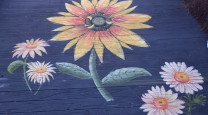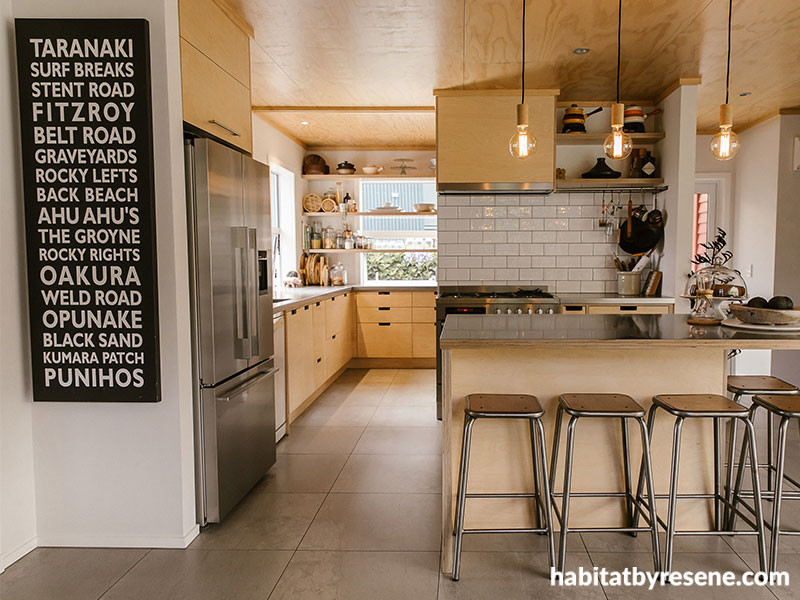
Easy-going interiors: How decorating a bach differs from everyday home design
17 Jan 2019
Whether by the beach, lake or mountain, the modest bach is an iconic part of our history and culture and sums up the meaning of escape from the city and ordinary working life.
“A bach represents a form of nostalgia harking back to a simpler life. It’s a sanctuary from urban business,” says designer Liz Kerby of Lizzie K & Co. “It’s a touchstone, a soulful place where you can add your own personality and character.”
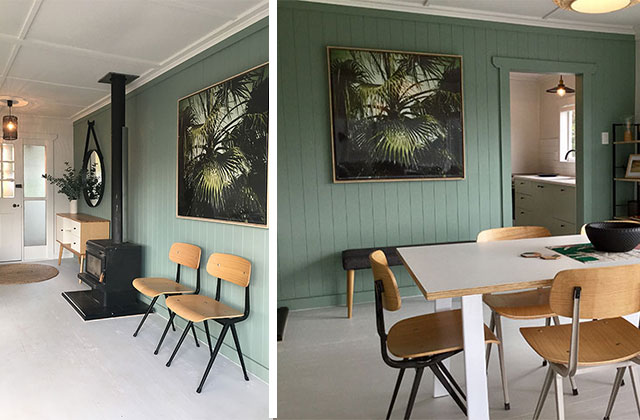
The colours Liz Kerby used when designing this Piha bach for her clients reflect the bush-clad hills and stormy coastline, using Resene Bluegrass on a tongue-and-groove wall that runs through the entry way and behind the dining space. All of the floors were painted in Resene Quarter Foggy Grey.
When designing a bach for clients, Liz set out to create a relaxed environment and an escape from city life. “We had a more textural look with second hand finds that immediately created a sense of nostalgia that was comforting. It can be quite different depending on where the bach is located. You might have lots of stone and a schist fireplace in an alpine region or lots of whitewashed timber floors, walls and ceilings or mats on walls in a coastal region.”
“There’s a playfulness to these holiday homes that comes from the history,” says Wellington architect Gerald Parsonson. “Having it beachy and basic is a good aspiration. Furnishings can be quite mad. It’s nice to turn up and kick sand through the house and not be hung up about kids and dog activity.”
When designing baches, he takes inspiration from the environment. “Every site is different. If it’s a steep site in the Marlborough Sounds, we’re influenced by how it fits on the land. If it’s a flat coastal site, then it’s a different dwelling.”
Layouts are determined as much by relaxed attitudes as modest budgets. Hence the lack of front entries, says Gerald. “Baches can be quite casual in the way bedrooms come off living areas and so on. They have multi-purpose spaces. A bedroom might be behind sliding doors.
“You can use basic materials and colour more playfully. Old baches were typically slapped together with fibre-cement cladding. It was easy to knock them up in plywood, so we’ve tried to use these sorts of materials. They’re really low maintenance and easy to paint,” he says.
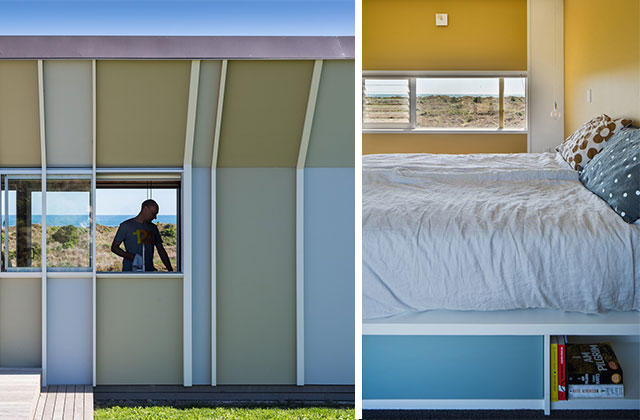
Gerald Parsonson’s clients Richard Stewart and Kerry Sexton wanted their holiday home in Te Horo, north of Wellington to feel like a bach, not a house that happens to be at the beach. He designed a small 87m2 retreat that was economical to build in fibre-cement and batten cladding with a simple pitched roof angled to catch the nor-wester breeze and shelter from southerlies. This bach recently won Gerald a Resene Total Colour Award for both its interior and exterior.
Designer Anna Major from Haus of Design in New Plymouth also encourages her clients to be sympathetic to the surrounding beauty. “In Taranaki, we’re inundated with beauty in our mountain and coastal areas.” For remote locations, security is often key, says Anna. When she designed a new bach in Oakura recently, it was about creating the ability to lock up and leave, so she specified sensor lights and aluminium joinery.

Anna Major designed a bach with two personalities – choosing bold Resene Pioneer for the exterior but a more muted palette inside with plywood finished in Resene Aquaclear, walls in Resene Sea Fog and a feature wall in Resene Gravel.
In regions of high salt exposure, she uses premium Resene Lumbersider for exterior walls and inside, she uses Resene SpaceCote – “you can wash it and it won’t tarnish. It’s a premium washable paint that avoids a lot of fingermarks on the walls.” Anna recommends hardwearing materials for easy-care. When it comes to furnishings, Anna says: “There’s so much available in op shops for crockery and beachy elements. Also look for country-style furniture that’s been re-upholstered. Focus on quality over quantity.”
Bach styles to try

Beachy – use Resene Colorwood Whitewash and chalky whites like Resene Merino, along with faded blues and green-edged sand colours like Resene Slipstream and Resene Smoothie. Decorate with driftwood, shells, beach ornaments, Cape Cod chairs, ceramic or metallic fish, colourful canvas stripes, log fires and window shutters.
Retro – play up the heritage aspect of existing baches. Update existing retro kitchens with colourful cabinetry and funky handles, kitsch art and objects from junk shops, second hand furniture, Crown Lynn china and old photos in frames. Retro colours to try include teals, mustards and oranges like Resene She’ll Be Right, Resene Cleopatra and Resene Adrenalin.
Nautical/boathouse – decorate with whitewashed floors and walls, painted oars, marine inspired tongue and groove, colourful canvas stripes, charts and maps, natural rattan shades and weathered surfaces. Try accents of navy and stormy blues like Resene Submerge and Resene Coast.
Surfy – use primary accents alongside surf boards, surf shop art, caps and bags in surf brands, denim cushions and surf break prints. Colours to try are fresh yellows, reds and greens like Resene Chorus Line, Resene Poppy and Resene Away We Go.
Rustic and raw – use plywood, concrete, upcycled timber furniture, chunky tables, rusted metals. Protect timber walls and ceilings with a durable urethane like Resene Aquaclear, timber floors with Resene Qristal ClearFloor and concrete floors with Resene Concrete Wax.
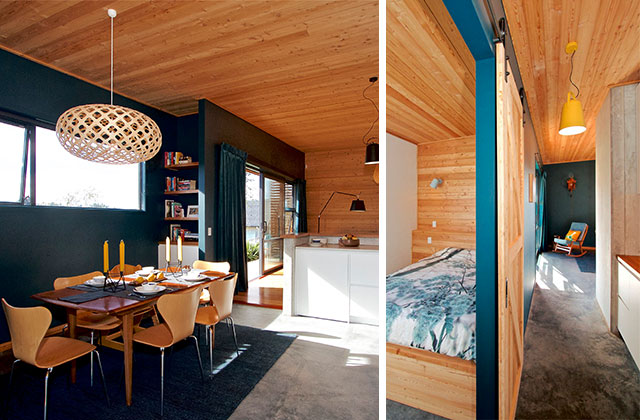
When Maurice Reeger of MnM Design created his own alpine retreat, he used Resene Elephant as a cool counterpoint to timber linings.
Header image: Interior designer Anna Major from Haus of Design created a contemporary interior with a muted palette for this Taranaki bach using plywood finished in Resene Aquaclear urethane and walls in Resene Sea Fog.
Published: 17 Jan 2019


